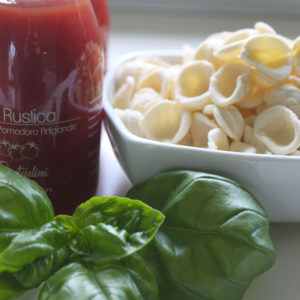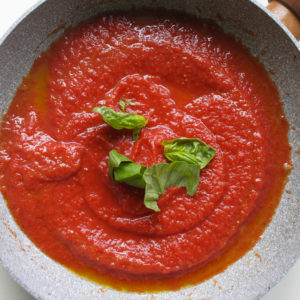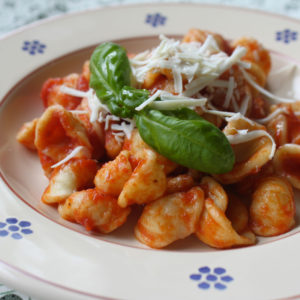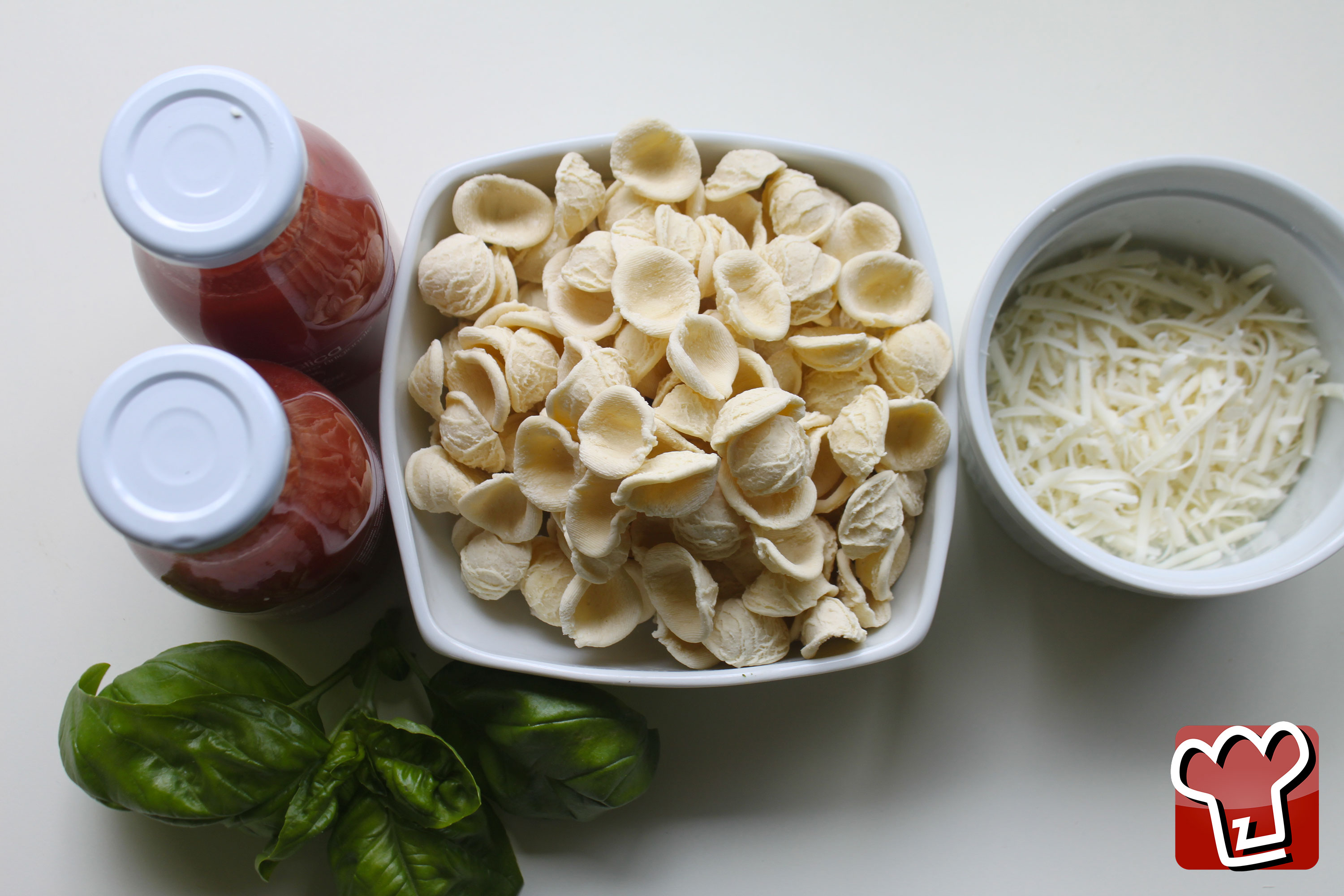Orecchiette pasta with tomato and cacioricotta cheese
There is nothing more delicious and irresistible than a lovely pasta dish based on tomato sauce, especially if it is made as it should and in perfect Puglian style! This means homemade pasta, a tomato sauce made at home or if not organically produced, only Puglian cacioricotta cheese, and, if possible, some basil leaves from your own balcony!
Ingredients
-
extra virgin olive oil
-
Cacioricotta cheese

Send the recipe
Preparation
Gently fry a little spring onion in a extra virgin olive oil in a pan, add the tomato passata, a little basil and salt, and then continue cooking everything together. Boil the pasta in salted water. Drain and then combine with the sauce in the frying pan. Finish with a good drizzle of extra virgin olive oil, fresh basil and a generous grating of cacioricotta cheese.
Step by step
|
View the step by step

|
Use only high quality ingredients
|
|
View the step by step

|
Cook the sauce
|
|
View the step by step

|
Mix the sauce with the pasta and finish with a grating of cacioricotta cheese
|
Additional Information
Orecchiette al Pomodoro: A Symbol of Pugliese Tradition
Orecchiette al pomodoro is one of the most iconic dishes of Pugliese and Italian cuisine. This unique pasta shape, resembling small ears, is perfect for capturing the intense flavor of fresh tomato sauce. The simplicity of this dish hides a depth of flavor that comes from the quality of ingredients and respect for tradition. It’s not just a first course but an experience that evokes the aromas and colors of Puglia, a land of sun and authentic flavors.
Making orecchiette with tomato sauce is an act of love for Italian cuisine, with its focus on seasonal ingredients and simple yet irresistible flavors. The orecchiette al pomodoro recipe has been passed down from generation to generation, with each family having its own variation, which might include cheese or other regional ingredients.
The Origins and Tradition of Orecchiette
Pugliese orecchiette with tomato have deep roots in the gastronomic culture of Puglia. It is said that this pasta shape originated in the Middle Ages when farming families handmade it using durum wheat semolina and water. The orecchiette were then dried in the sun, ready to be stored for use in the following months. Tomatoes, imported later from the Americas, added that touch of acidity and freshness that we now associate with this dish.
Orecchiette with tomato and basil is the most classic and widespread version. The aroma of fresh basil, combined with the sauce made from ripe tomatoes, creates the perfect balance of sweetness and acidity typical of Mediterranean cuisine. The simplicity of the ingredients makes this dish accessible to all, but it’s the quality that truly makes the difference.
Creative Variations of Orecchiette al Pomodoro
While maintaining the charm of tradition, orecchiette al pomodoro can be reinterpreted with the addition of ingredients that enrich its flavor and texture. One tasty example is orecchiette with tomato and ricotta. The creaminess of ricotta balances the tomato acidity, making the dish softer and suitable for those who prefer milder flavors.
Another popular version is orecchiette with meatballs in tomato sauce, where small meatballs are cooked in the sauce, adding bold flavors and a heartier texture to the dish. This version is ideal for those seeking a more substantial meal while still enjoying the goodness of fresh tomato sauce.
Modern variations include orecchiette with tomato and burrata, where tradition meets innovation: the dish is completed with creamy burrata, adding a touch of luxury and originality. Mozzarella is also a delicious addition, as seen in orecchiette baked with tomato and mozzarella, where the pasta is baked to create a crispy, irresistible crust.
Orecchiette al Pomodoro: A Versatile Dish
The versatility of orecchiette al pomodoro is one of the reasons why this dish is so beloved. Starting from a simple base, countless flavor combinations can be created. For those watching their diet, orecchiette with tomato and cacioricotta is a lighter but still tasty option, with cacioricotta, a light but flavorful Pugliese cheese, adding a savory note without making the dish too heavy.
For those who like to experiment, there are also baked versions like baked orecchiette with tomato or orecchiette with tomato in the oven. These variations require an additional step of baking, which gives the dish a crispy, gratin-like texture, thanks to the addition of cheese or breadcrumbs. The version with mozzarella is particularly loved by younger people, who enjoy the contrast between the soft pasta and the golden crust.
Another interesting version is farro orecchiette with tomato, a healthier, fiber-rich option that gives the dish a more rustic flavor while maintaining the classic taste of fresh tomato sauce.
Orecchiette al Pomodoro and Modernity
Orecchiette al pomodoro is a dish that has evolved with the times without losing its traditional roots. With the advent of modern kitchen appliances like the Bimby, preparing this dish has become even easier. Orecchiette al pomodoro Bimby allows you to speed up the cooking and preparation process while preserving the authentic flavors. In just a few steps, you can create the perfect dish, from the sauce to the orecchiette, without sacrificing quality.
One of the latest gastronomic trends is experimenting with tomato colors. Orecchiette with yellow tomato offers a refined and visually appealing version of the classic dish. Yellow tomatoes are less acidic and sweeter than their red counterparts, creating an interesting contrast with the pasta flavor, making the dish lighter and more delicate.
Orecchiette al Pomodoro: Calorie Count and Healthy Diet Tips
Orecchiette al pomodoro is also a balanced choice for those following a healthy diet. On average, a portion of orecchiette al pomodoro provides around 350-400 calories, depending on the amount of oil and cheese used. It’s a dish rich in complex carbohydrates, providing long-lasting energy, and low in fat, especially if minimal oil and cheese are used.
For those looking to reduce calorie intake further, farro orecchiette is a great alternative, containing fewer calories than traditional pasta and rich in fiber, helping maintain a longer feeling of fullness.
In conclusion, orecchiette al pomodoro is a versatile and rich dish with a long history that can be enjoyed in various versions without losing its charm. Whether you choose a classic version with tomato and basil or a more elaborate one with mozzarella or burrata, this dish remains a celebration of Italian cuisine in its purest form.




